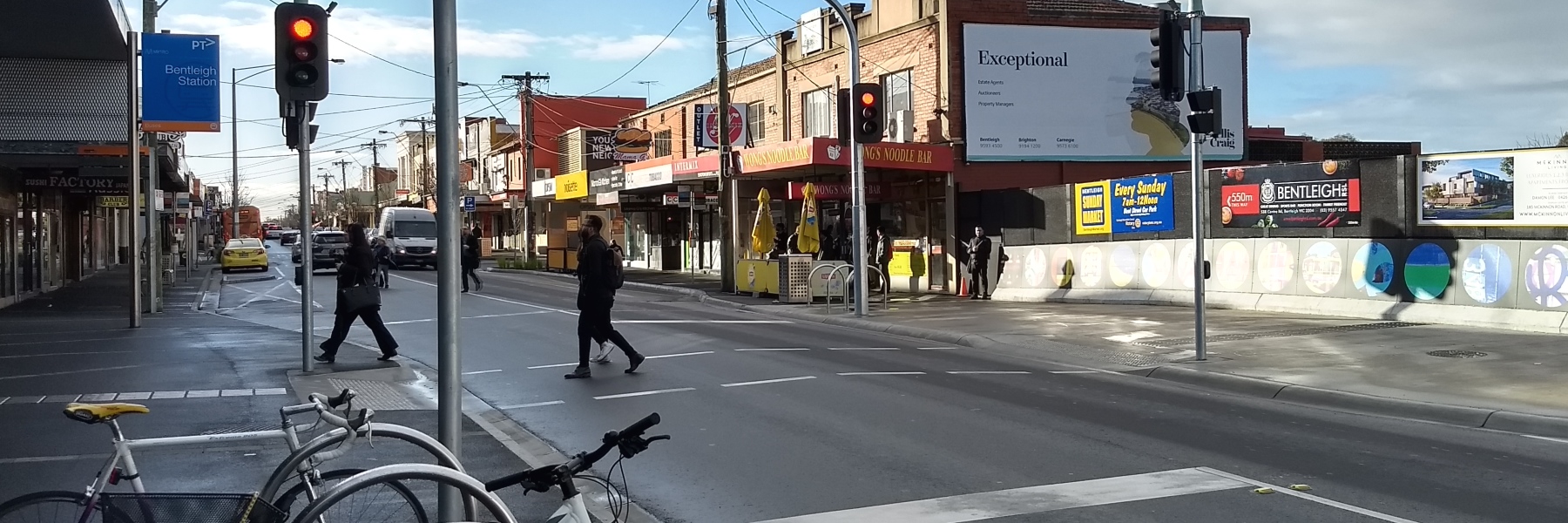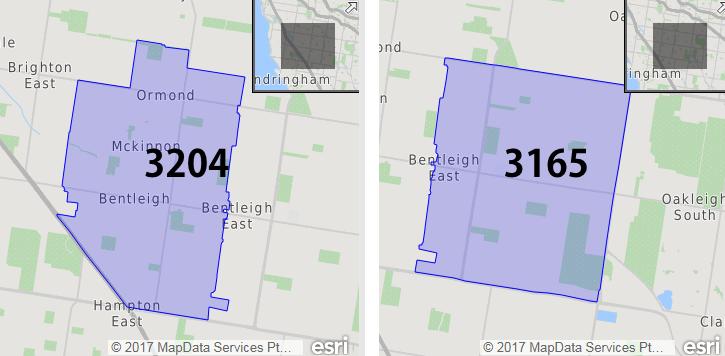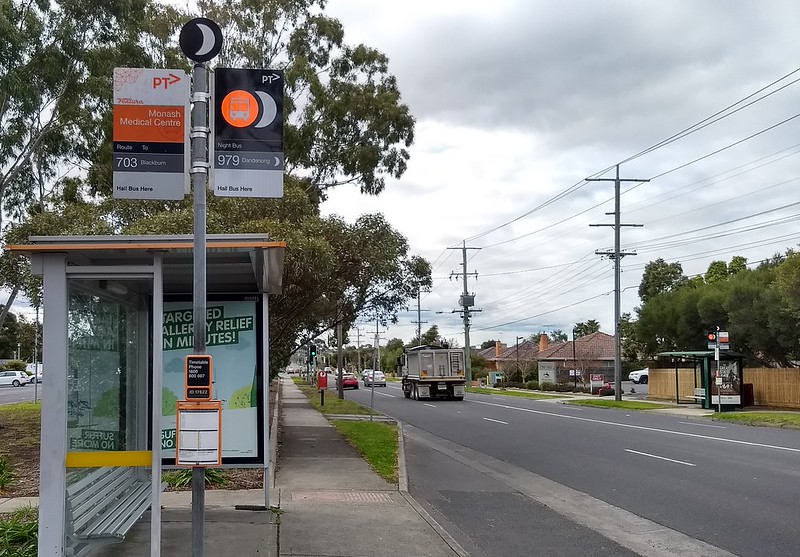Census data for Journey To Work was released on Monday, and many are taking a good look at the results.
In Greater Melbourne, overall about 16.3% of people are using public transport to get to work — up from 14.5% in 2011.
(It actually depends how you define “Melbourne”, and how you analyse the figures. I’m going to keep it simple and use the QuickStats figure for “Melbourne (Urban Centres and Localities)“, population 4.2 million, but people smarter than me are doing further analysis to get a more accurate figure — Charting Transport says 18.6%.)
Comparing the Bentleighs
Comparing Bentleigh (3204) with neighbouring East Bentleigh (3165), I found some interesting differences.
They have very similar populations. Bentleigh has about 31,000 people; East Bentleigh has 28,000.
Bentleigh median age 38, East Bentleigh 40.
Across both suburbs, there is an average 2.7 people per household, and in families with children, an average 1.8 children.
Transport
Diverting from the Census data for a minute, let’s look at the suburbs’ transport infrastructure and services.
Neither suburb has any freeways.
Bentleigh has four railway stations: Patterson, Bentleigh, McKinnon and Ormond are all within 3204; Moorabbin is just outside the southern border. All of these are within about a 15 minute walk. Services are about every 10 minutes for most of the day (the graph below excludes express services, which don’t stop in Bentleigh).
East Bentleigh only has buses. Major north-south routes include the patchy and indirect 822 and 767 services, plus the far better 903 Smartbus along Warrigal Road (on the suburb’s very eastern edge), which is reasonably good on weekdays as a feeder into Oakleigh or Mentone stations, with almost as many services per weekday as the trains.
Both suburbs are served by the 703, 630, 824 and other local buses providing east-west services, but none of them are as frequent as the trains, particularly after 7pm and on weekends.
Buses of course get stuck in traffic, and average speeds are slower than trains. The 903 from Mentone to Chadstone, about 11 kilometres, is scheduled at 45 minutes in peak hour. Frankston line stopping-all-stations trains (which serve Bentleigh) cover the 12 kilometres from Mentone to Caulfield in 24 minutes in peak.
This graph shows that the Frankston line provides far more services than most of the bus routes. This is especially marked on the weekend, which doesn’t directly affect the Census results, but influences whether people feel they can depend on public transport for their travel generally.
Note: these figures simply add weekday + Saturday + Sunday services in both directions, so this is not a weekly service figure. Express trains that don’t stop at stations within Bentleigh are excluded.
Transport outcomes
Back to the Census. How does this play out in the transport modes people use?
Here’s what the Census Quickstats tells us:
In Bentleigh, 20.8% of people get to work by public transport, well above the Melbourne average. In East Bentleigh it’s 14.9%, slightly lower than the Melbourne average. So Bentleigh is about 40% higher than East Bentleigh.
In Bentleigh, average number of motor vehicles in the home is 1.7 — most popular answer: one (39.4%). East Bentleigh average is 1.8, most popular answer: two (44.3%).
In Bentleigh, 7.4% of households have no motor vehicle. In East Bentleigh it’s only 4.7%.
(If 46.8% of households in Bentleigh have zero or one car, you can bet those are mostly near the stations. Perhaps it’s perfectly reasonable for new apartment developments to be built with one car space, with no street parking?)
What can we learn?
Owning an extra motor vehicle has a huge economic impact on a household. It can easily add up to thousands of dollars per year.
Of course, 20.8% public transport mode share in Bentleigh is higher than many suburbs (certainly well above the Melbourne average), but is not as high as it could be.
The relevant data isn’t available yet, but my suspicion is that public transport mode share is very high for trips to work along the train line, particularly to the CBD and inner suburbs — and Southland will be another major rail destination once the station opens in November.
But public transport mode share is likely to be much lower for trips not served by rail — probably not much higher than non-rail suburbs, because most of the buses (even the 703) offer such poor service.
This pattern would be repeated right across Melbourne. Correlation isn’t causation, but it’s pretty clear that in suburbs with good public transport options, people use it more often, particularly where the service offers a good quality ride to a major destination.
The key is to keep improving the non-car options: walking, cycling, and of course the public transport service.
Not just trains, but also buses and trams, and giving every suburb transport options that are competitive with car travel, more of the time.
For PT that means ride quality, reliability, speed/priority, but most of all, service frequency.



14 replies on “A tale of two Bentleighs”
Daniel, excellent piece of analysis.
Groups like the Productivity Commission love buses since they require little fixed infrastructure and routes can be altered quickly as demand changes. But trains are much faster and more reliable so more people use them.
BTW, high CBD parking costs is the reason most people use PT to get to their city work place rather than car, ahead of traffic related reasons.
“Perhaps it’s perfectly reasonable for new apartment developments to be built with one car space, with no street parking?)”
You see this sort of comment a lot, and frankly I think it is slightly offensive. Australians still tend to see living in apartments as being for the poor, the transient, the young, the old, or people who haven’t saved enough yet to buy a house. Most adults work, and these days many partnered adult women work for quite a few years before having children and stopping work, in many cases. And these days, most women with children would find a car almost indispensable in their normal daily lives.
It’s all very well if one or both work in the CBD. But if you have to work anywhere else, getting to work by public transport can become extremely burdensome.
The point is, people’s circumstances vary, a lot. And those circumstances change. Doctrinaire neo-stalinist policies that dictate to people based on some kind of homo economicus viewpoint [ getting to work is the only legitimate transport need ], or that nobody ever has visitors, or that nobody has adult working children still living “at home”, or that at least one member of every working couple will have a job in the CBD, are recipes for social and planning failure.
Before I get labelled as some kind of luddite, I’d point out that I have spent many more years than most people working and getting around without a car. It amazes me, when I visit the company’s office in Melbourne, and nobody except me even has a myki at all, they are so wedded to their cars there.
@enno, “slightly offensive”? You’re kidding me.
If 47% of households in a suburb have less than two cars, because they choose to make some (or perhaps even all) trips without driving, why should they be forced to pay for additional car spaces they won’t use?
well it is not you being offensive, it is the town planners. Maybe patronising is another word.
The key words are “people’s circumstances vary, a lot”. And “choose”.
47% of people living in some suburbs have less than two cars, but then remember that probably 37% of those would be single-person households, and also that probably quite a few of those single-person households are elderley or disabled people. Single person households have a quite limited need for two cars.
People’s circumstances vary. Some households need zero cars. Some households need two. Housing is very expensive , people cannot just up and move at the drop of a hat.
What if you are a single person and you have a job and a unit and a car? And you meet a nice woman who also has a car. She can’t move in with you.
Or you are a working couple and one of your works downtown and takes the train. And suddenly they get sent by their job to work somewhere else ? I’ve been in that situation and was forced to resign, except they changed their mind about the move.
Or the situation I was once in, when I worked for a company which had company cars for the executives only, and sometimes they wanted to send me to meetings in rural places, and they had a few spare company cars for people doing errands like that, and to get an early start on the trip, I had to take the company’s car home the evening before, and they wanted me to sign an agreement that I was entirely responsible for any damage to the car if it wasn’t garaged during the night. Apparently these old-skool suburbanites had never even considered the idea that one of their professional employees might live in a unit with no off-street parking. Or with one off-street park, which is where my wife’s car lives.
Over and over again, the “planners” keep telling people “they will have to get used to it” – living in units. And yet so many people find living in units to be a ratshit experience. Can’t get internet. Can’t get reliable postal deliveries. Can’t park. Can’t smoke or do what you want in your own home. Can’t have a pet. Can’t have friends over because they can’t park and can’t make any noise. And the same “planners” have not delivered the level of public transport or internet-everywhere or appropriate building standards which make living in an appartment a non-intolerable experience. It’s a case of the planners talking the talk but not walking the walk.
The subtext message is still loud and clear. Apartment-living is for losers. People who have the lifestyle that want to live in Docklands and be near the Skybus and have no friends or relatives or activities to go to in suburbia or anywhere else, are making a lifestyle CHOICE. As economic necessities force LONG-TERM apartment living onto more an more ordinary Australians, including ordinary Australians with children, by necessity and not by choice, then they can well do without the patronising assumptions that they are all the same, that they have nowhere to go except go to work, and that if they are not single, they have no independent activities or life and if they want to go out, they must do so joined at the hip.
The days of usable public transport everywhere, or autonomous cars to go everywhere, or even the legalisation of chinese electric motorscooters, may be coming, but they are not here yet.
If 47% of households in a particular area are single person households, then you can work out that that is only about 21% of the people living in a particular area.
@enno
If you see a piece of real estate sold with 1 parking or without parking, in an area with restrictive parking laws, you would probably take into account as part of the decision to move there. You woudn’t move there and then go, “Oh! We can’t drive?”.
Personally I live in a house with two cars, and yet my partner and I get to work in the eastern suburbs purely with public transport. The journey takes just a bit more than an hour, but I no longer see the point of getting stuck in traffic.
I suspect that the parking charges for staff at Southland will/have cause(d) an increase in PT to get to work in Southland. The Frankston line, 822 and 767 will be the primary beneficiaries in Bentleigh and East Bentleigh but the 630, 626, 703, 824 and maybe even 701 will help feed the Frankston line with Southland workers. The 903 has very poor connections to Southland, especially from East Bentleigh.
Interesting stats and analysis Daniel.
I live in Bentleigh. I drive but I don’t own a car. Earlier this year I got sick of delayed/full trains on the Frankston line so invested in a pedelec pedal assist bike and now ride 45 mins into work and then 45 mins home every day. If I happen to have a work car for the night and drive to work in peak hour instead it takes at least 55 minutes to get into the CBD. I really think Bentleigh is still in that sweet spot for riding to work but it has atrocious cycling infrastructure. There’s not even bike hoops to park the bike along Centre Rd and as it’s not safe to ride on the Nepean Hwy I ride in the terrible cycling tracks alongside it (though these disappear occasionally). I know that cycling is low down on PT options to work but I wish more people would take it up and there was some solid investment in cycling infrastructure.
Certainly need some solutions and NOW! The trains are already packed to capacity and will only get worse. Buses are for people who have time on their hands. Really not an option.
And here’s another thing.
People’s actual transport behaviour depends on the opportunities and facilities available to them, where they live.
But people also choose where to live based on what they perceive their transport needs to be for the forseeable future at the time they make the choice – circumstances which might always change anyway.
People who work downtown or expect to work downtown in the future, are more likely to pay more to live in suburbs with a station on the train network.
People who don’t work downtown, drive somewhere to work which is not particularly convenient to reach by public transport, are more likely to choose houses, often slightly cheaper houses, in suburbs which are not directly on the rail network.
Anyone’s choice of a domicile, particularly buying a home in which they expect to live for quite a long time, is going to depend on a whole lot of factors, but what is going to vary here is the weighting that they attribute to those factors. There is not much point paying an extra $100k for a house near the station, if you don’t work downtown or are unlike to do so. You can spend less money, or spend the same money and get a nicer house somewhere further away.
The conclusion along the lines that “more people in east bentleigh are “forced” to drive to work, because the public transport is mediocre”, would be the wrong conclusion to draw. The alternative conclusion that “other things being equal, people to drive to work are more likely to buy houses in East Bentleigh, than Bentleigh”, would be equally valid. Other things being equal.
I am also dubious about the claim that it always takes at least 55 minutes to drive from Bentleigh to the CBD. When I lived at Black Rock, it never took that long. it’s further. Are you sure you know the way ?
Google Maps predicts 22 to 63 minutes, leaving Bentleigh at 7:30 AM. There’s obviously quite a variation there.
It is not just CBD and surrounds jobs (and education, services, etc) that rail is useful for, for anything along your rail line it is useful. Caulfield and Frankston are major centres of rail accessible jobs etc., on the Frankston line, and Southland is about to join them.
People working near ordinary suburban stations often live in the surrounding area and walk to work and thus walking distance of a station has a significant benefit to them even without them engaging in any rail travel (which they may still do for other reasons that work).
That’s quite true, but the surface of the planet, or a subset of it, is a two-dimensional space, and any single one-dimensional line representing your local railway is only a small subset of that.
There are 4 medium-large shopping centres within about 8 km from my place. Two are along the railway line and two are not. When I had a car previously, I used to visit all four of them from time to time. Then I didn’t have a car for almost five years, and during that entire time I visited the two shopping centres not along the railway a total of once and zero times respectively.
[…] It’s quite reasonable to assume that people living close to a railway station will (at least on the better served lines) be able to often use that service instead of driving. At the very least, they might be able to own fewer cars in their household than they would elsewhere. […]